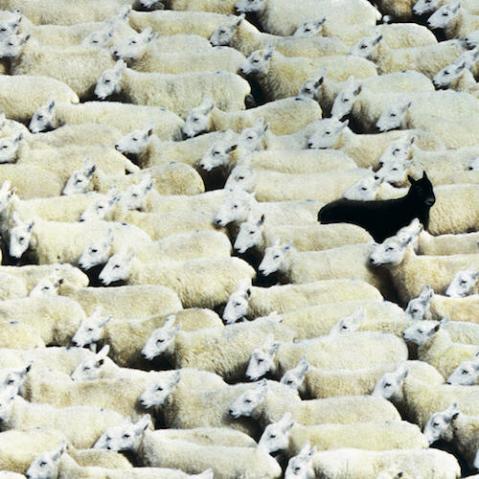How to photograph a dark subject against a light background
All in-camera and handheld meters are designed to operate on the premise that everything that you’re metering produces an average amount of reflectance or, in photographic terms, about 18-percent reflectance.
 This is an extremely challenging exposure scenario—with a jet-black subject in shadowed foreground in front of an area receiving direct midday sun. Just enough shadow detail is kept to see the puma’s eyes and whiskers, but most of the body is allowed to fall into pure black.
This is an extremely challenging exposure scenario—with a jet-black subject in shadowed foreground in front of an area receiving direct midday sun. Just enough shadow detail is kept to see the puma’s eyes and whiskers, but most of the body is allowed to fall into pure black.
This concept, however, would mean that for every exposure reading to be completely accurate without any intervention from you, we would need to live in a world where everything, regardless of colour had the exact same single tonality. Not only would this be an intensely boring world visually, but it would probably spell the end of photography as a hobby.
Fortunately for our imaginations and visual pleasure, the world is made up of a vast range of tonalities. But in order to record these many tones on a sensor that has a limited dynamic range, it’s often necessary to make difficult decisions when it comes metering and setting exposure.
Capturing detail in a dark subject set against a lighter background presents a challenge of balancing exposure: You want to record detail in the darker areas but don’t want to lose detail in the lighter tones. Suppose you are photographing a black bull standing against a white barn, for example, and you read just the bull and get a reading of 1/250 at ƒ/8. If you set your camera to this reading you will get a bull that is closer to middle grey than black. In order to darken the bull, you would need to reduce the exposure—probably by a full stop or more. By setting the exposure at 1/250 second at ƒ/16, for instance, you have reduced exposure for the dark subject by a full two stops which is probably enough to render that subject as black but with some surface detail. If you underexpose too much, of course, you begin to lose important surface texture and detail.
In terms of the bright background, however, as you reduce exposure for the bull you will simultaneously bring down the brighter values in the barn wall. If the contrast is not too extreme this may enable you to get the darker tonality that you want in your main subject while also maintaining detail in the lighter background areas. It’s definitely a bit of a tightrope walk in many situations.
 In order to preserve the peaceful, meditative expression on this subject’s face (and avoid rendering her as a complete silhouette), a balance had to be struck between her shadowed figure and the bright tones of the background.
In order to preserve the peaceful, meditative expression on this subject’s face (and avoid rendering her as a complete silhouette), a balance had to be struck between her shadowed figure and the bright tones of the background.
If the dynamic range between the bull and the wall is too extreme, of course, you still may not be able to reduce he exposure sufficiently to hold detail in the white background. If detail in that area is crucial to your photo, then it is probably worth underexposing the darker areas in-camera and then opening them up during editing. Alternately, of course, you could use a reflector or flash to raise up the exposure of the darker areas—provided that doing so didn’t destroy the richness of the darker tones.
Again, it’s far easier to brighten a dark area in editing and rescue some detail there than to try and recoup highlight detail, while staying aware of the risk of enhancing noise in the boosted shadow areas. As a general rule in digital photography, the highlights are to be preserved at (almost) all cost, because if something is lost to pure white, there will be no detail at all to recover, no matter how much editing you do.
In metering either type of scene—dark against light or light against dark—it’s vitally important that you use a selective meter reading so that you are sure that the background is not influencing the reading from your main subject.
Michael Freeman’s Photo School: Exposure is Michael Freeman’s and Jeff Wignall’s guide to leaving auto mode in the dust and taking complete creative control of your images. Michael Freeman and Jeff Wignall bring their years of experience to the table regarding photography’s fundamental principles and teaching you all the professional techniques so you can nail the optimal exposure in-camera at the moment of capture, every time.
 Michael Freeman’s Photo School: Exposure
Michael Freeman’s Photo School: Exposure
Michael Freeman and Jeff Wignall
Buy it now!
RRP for print edition: £17.99







